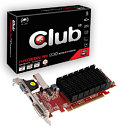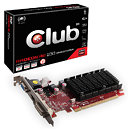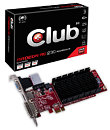Thursday, April 3rd 2014

Club 3D Introduces Its Radeon R5 Series Graphics Cards
Club 3D, the renowned Dutch manufacturer of AMD based graphics cards is proud to announce the completion of our range of graphics cards. At the end of 2013, the incredibly powerful 'Hawaii' GPU marked the debut of the brand new Radeon R9 series. After several generations AMD dropped the 'HD xxx' model names in favor of the new R- series structure.
The R series consists of the R9 high performance graphics cards targeted at the most demanding PC gamers. Next is the R7 series. Cards in the R7 series are capable all-rounders with the power to do it all. So far there was no part of the R series aimed at entry level cards. This is about to change with the launch of the Radeon R5 series.Integrated graphics solutions in modern CPUs are getting increasingly powerful but there remains a strong demand for discrete entry level GPUs to either use for new systems or to upgrade the graphic performance of existing systems. In the Radeon R5 series we will launch three different SKUs, all of which are passive cooled to ensure completely noiseless operation.
The Club 3D Radeon R5 230 1024 MB (CGAX-R5232L) is a low profile card fitted with a Caicos PRO GPU. It has 160 Stream Processors, a clock speed of 625 MHz and comes with 1024 MB of DDR3 memory at 1334 MHz. It fully supports DirectX 11 and OpenGL 4.2 and uses a mere 19 Watts under load. The card comes standard with two Low Profile brackets allowing it to be fitted in most Small Form Factor (SFF) chassis.
Next is the Club 3D Radeon R5 230 2048 MB (CGAX-R5236L). It uses a similar Caicos PRO GPU with 160 Stream Processors and clock speed of 625 MHz. The main difference is the increased memory size of 2048 MB to offer more headroom when using heavy applications. The R5 230 2 GB also uses a passive alloy heat sink without a fan to ensure noiseless operation. It ships with two Low Profile brackets for use in Small Form Factor (SFF) chassis or HTPC configurations.
The third and last Club 3D Radeon R5 card we launch today is the R5 230 1024Mb PCIE 1X version. This is a more specific version because of its 1X bus. PCI-E stands for Peripheral Component Interconnect Express. Its a high speed serial computer expansion bus and basically comes in 4 physical variants, X1, X4, X8 and X16. Most common slots used on current motherboards are the X16 and X1 versions. The big advantage is that X1 cards can be used in any PCI-E slot, from X1 to X16 specifications. Therefore this is a very flexible solution not only for use in mini PC's featuring a PCIe X1 slot but also for use as second or even third graphics card in 'normal' sized (micro) ATX systems. The Club 3D Radeon R5 230 PCIE 1X also comes with the Caicos PRO GPU offering 160 Stream Processors, a clock speed of 625 MHz and 1024 MB of DDR3 memory at 1334 MHz. It is passive cooled, uses only 19 watts in load and comes standard with two Low Profile bracket.
All three Club 3D Radeon R5 230 cards feature a Dual Link DVI-D, HDMI and VGA output. The cards are expected to become available in etail and retail in the coming weeks.
The R series consists of the R9 high performance graphics cards targeted at the most demanding PC gamers. Next is the R7 series. Cards in the R7 series are capable all-rounders with the power to do it all. So far there was no part of the R series aimed at entry level cards. This is about to change with the launch of the Radeon R5 series.Integrated graphics solutions in modern CPUs are getting increasingly powerful but there remains a strong demand for discrete entry level GPUs to either use for new systems or to upgrade the graphic performance of existing systems. In the Radeon R5 series we will launch three different SKUs, all of which are passive cooled to ensure completely noiseless operation.
The Club 3D Radeon R5 230 1024 MB (CGAX-R5232L) is a low profile card fitted with a Caicos PRO GPU. It has 160 Stream Processors, a clock speed of 625 MHz and comes with 1024 MB of DDR3 memory at 1334 MHz. It fully supports DirectX 11 and OpenGL 4.2 and uses a mere 19 Watts under load. The card comes standard with two Low Profile brackets allowing it to be fitted in most Small Form Factor (SFF) chassis.
Next is the Club 3D Radeon R5 230 2048 MB (CGAX-R5236L). It uses a similar Caicos PRO GPU with 160 Stream Processors and clock speed of 625 MHz. The main difference is the increased memory size of 2048 MB to offer more headroom when using heavy applications. The R5 230 2 GB also uses a passive alloy heat sink without a fan to ensure noiseless operation. It ships with two Low Profile brackets for use in Small Form Factor (SFF) chassis or HTPC configurations.
The third and last Club 3D Radeon R5 card we launch today is the R5 230 1024Mb PCIE 1X version. This is a more specific version because of its 1X bus. PCI-E stands for Peripheral Component Interconnect Express. Its a high speed serial computer expansion bus and basically comes in 4 physical variants, X1, X4, X8 and X16. Most common slots used on current motherboards are the X16 and X1 versions. The big advantage is that X1 cards can be used in any PCI-E slot, from X1 to X16 specifications. Therefore this is a very flexible solution not only for use in mini PC's featuring a PCIe X1 slot but also for use as second or even third graphics card in 'normal' sized (micro) ATX systems. The Club 3D Radeon R5 230 PCIE 1X also comes with the Caicos PRO GPU offering 160 Stream Processors, a clock speed of 625 MHz and 1024 MB of DDR3 memory at 1334 MHz. It is passive cooled, uses only 19 watts in load and comes standard with two Low Profile bracket.
All three Club 3D Radeon R5 230 cards feature a Dual Link DVI-D, HDMI and VGA output. The cards are expected to become available in etail and retail in the coming weeks.



7 Comments on Club 3D Introduces Its Radeon R5 Series Graphics Cards
Not that I'm not happy with my 5450. It is there just to boot the thing...
Also Intel Integrated Graphics (HD 4000 and below) only support 2 screens. If you could link me a motherboard that supports triple monitor setups, that would be great information to know. Most motherboards have 3 outputs, but can only drive 2 of them at once.
Congratulations. We've discovered these cards are pointless for you. You don't speak for every other computer user, both basic, corporate and enthusiast.